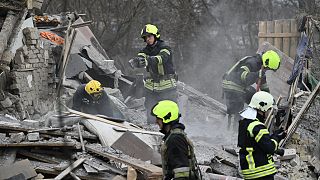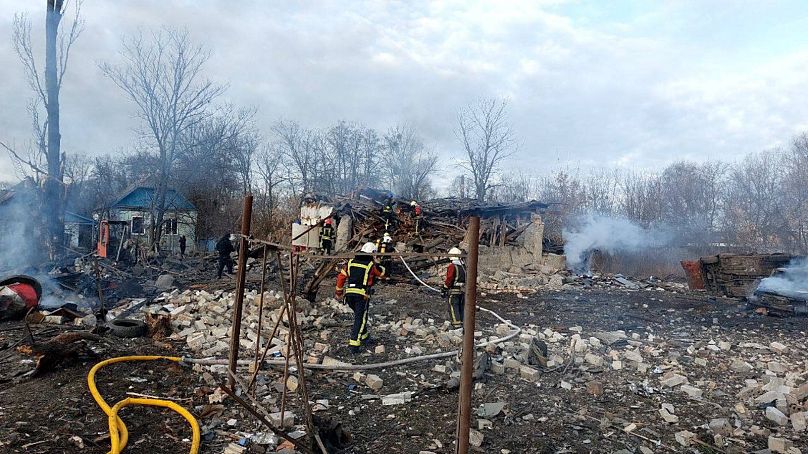Multiple regions of Ukraine, including its capital, faced a massive Russian missile attack Thursday, the biggest wave of strikes in weeks targeting power stations and other critical infrastructure during freezing weather.
Rescuers clear debris of homes destroyed by a missile attack in the outskirts of Kyiv,
on December 29, 2022 – Copyright AFP
Air raid sirens rang out across the country. There were initial reports of 120 missiles fired by Russia, however, Ukraine’s military chief General Valerii Zaluzhnyi said preliminary data showed Russia fired 69 missiles at energy facilities and Ukrainian forces shot down 54 of them.
There were no immediate reports of any deaths.
Russia dispatched explosive drones to selected regions overnight before broadening the barrage with “air and sea-based cruise missiles launched from strategic aircraft and ships” in the morning, the Ukrainian air force reported.
The widespread attack was the latest in a series of Russian strikes on power and water supplies that have increased the Ukrainian population’s suffering. Moscow has launched such attacks on a weekly basis since October, while its ground forces struggle to advance.
On Thursday, air defense systems were activated in the capital, Kyiv, to fend off strikes, according to the regional administration. Sounds of explosions were heard in the city.
At least three people were wounded and hospitalised, including a 14-year- old girl, Mayor Vitali Klitschko said. He warned of power outages in the capital, asking people to stockpile water and to charge their electronic devices.
Ukrainian Foreign Minister Dmytro Kuleba condemned Russia for launching the missiles amid the winter holidays, calling it an act of “senseless barbarism.”
“There can be no ‘neutrality’ in the face of such mass war crimes. Pretending to be ‘neutral’ equals taking Russia’s side,” Kuleba tweeted.
After more than 10 months of fighting, Russia and Ukraine are locked in a grinding battle of attrition. The Ukrainian military has reclaimed swaths of Russian-occupied territory in the country’s northeast and south, and continues to resist persistent Russian attempts to seize all of the industrial Donbas region.
At the same time, Moscow has methodically targeted Ukrainian power facilities and other key infrastructure in a bid to weaken the country’s resolve and force it to negotiate on Russian terms.
While the Ukrainian military reported success in shooting down incoming Russian missiles and explosive drones after earlier attacks, some still reached their targets. Most cities have gone without heat, internet service and electricity for hours or days at a time.
Anastasia, a medic who took shelter Thursday at a central Kyiv subway station and gave only her first name, said she was tired of the war. “We don’t know how long the war will last. It’s hard to be afraid every day and put your life on hold,” she said.
Russian missiles shot down
Numerous explosions also took place in Kharkiv, which is located in eastern Ukraine and the country’s second-largest city, and in the city of Lviv near the border with Poland, according to their mayors.
About 90% of Lviv was without electricity, Mayor Andriy Sadovyi wrote on Telegram. Trams and trolley buses were not working, and residents might experience water interruptions, he said.
Ukrainian authorities in several regions said some incoming Russian missiles were intercepted.
The governor of southern Ukraine’s Mykolaiv province, Vitaliy Kim, said five missiles were shot down over the Black Sea. The Ukrainian military’s command North said two were downed over the Sumy region, located on the border with Russia in the country’s northeast.
Fragments from downed Russian missiles damaged two private buildings in the Darnytskyi district of Kyiv, the city administration said. An industrial facility and a playground in neighborhoods located across the Dnieper River also were damaged, city officials said. No casualties were immediately reported.
As the latest wave of Russian strikes began Thursday, authorities in the Dnipro, Odesa and Kryvyi Rih regions said they switched off electricity to minimize the damage to critical infrastructure facilities if they were hit.

